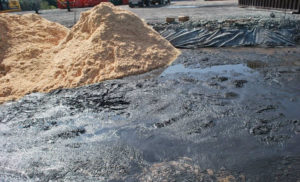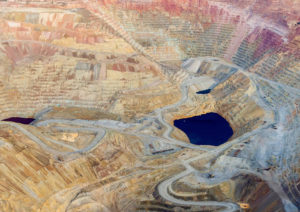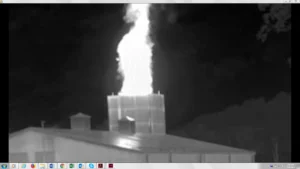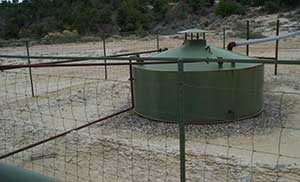There are many fluids and wastes associated with oil and gas operations that can poison living organisms. This web page contains information on some of the following issues of concern related to the storage and disposal of oil and gas wastes:
- How pit pollution occurs
- Soil and water contamination from pits
- Wildlife and livestock mortality related to pits
- Toxic materials stored and disposed of in pits
Visit our Alternatives to Pits web page, to find out how the oil and gas industry can reduce the environmental impacts and hazards posed by oil and gas pits.
How pit pollution occurs
Pits are used to store a variety potentially toxic, as well as non-hazardous liquid and solid wastes associated with oil and gas development.
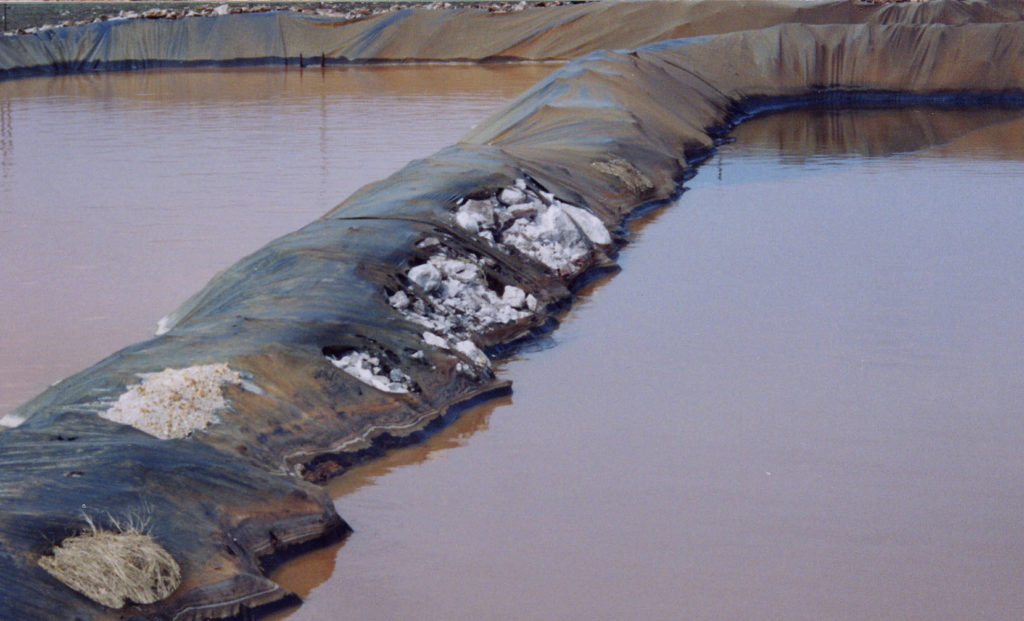
Solid wastes may contain toxic substances. If left on site they may:
- Leach out of the solids and contaminate groundwater
- Contaminate soils and vegetation
- Sterilize soils and prevent vegetative growth
Liquid wastes may contain toxic substances that can:
- Overflow the sides of the pit (e.g., during a rain event, or due to inadequate storage volume of the pit) and pollute soil and surface waters
- Leach directly into the ground (if stored in unlined pits) and contaminate soil and water.
- Seep into the ground (even if the pits are lined) through tears in liners, allowing substances to leak through to the soil and groundwater. Even if pits are lined, the liners are often improperly installed, or are torn, and frequently leak
Soil and water contamination from pits
Between the mid-1980s and 2003, the New Mexico Environmental Bureau recorded 6,700 cases of pits causing soil and water contamination in that state.[1] In 2005, the New Mexico Oil Conservation Division released data showing that close to 400 incidents of groundwater contamination had been documented from oil and gas pits. Find out more about groundwater contamination from oil and gas industry pits in New Mexico.
The City of Lovington, New Mexico, has experienced soil pollution from oil spills and pits. In recognition of the contamination threats posed by oil and gas drilling wastes, and in an effort to protect its municipal water supply, Lovington recently banned the use of drilling pits on the city’s water field. For more information on Lovington, read the OGAP report Pit Pollution.
Soil contamination from pit pollution can inhibit the health and growth of vegetation on-site, which may lead to soil instability and erosion. Also, vegetation may uptake the contaminants and cause health problems for animals that eat the contaminated plants.
Similarly, if the contaminants enter surface or groundwater, organisms (humans, livestock, wildlife, aquatic life, micro-organisms) drinking or living in the water may experience negative health effects or death, depending on the level of contamination.
Between 1996 and 2002, the U.S. Environmental Protection Agency (EPA) in Wyoming, Utah, Colorado, Montana, South Dakota and North Dakota conducted 475 field inspections at sites having one or more production pits or commercial facilities using disposal pits. Problems were found at 290 (more than 60%) of the sites. Issues of concern included:
- Ongoing discharges to surface and groundwater were documented at 22 % of the sites inspected, and those discharges were unpermitted at 35 of those sites (34% of the sites with ongoing discharges observed).
- Leaks and spills were observed from equipment. · Secondary containment for oil storage tanks was inadequate or non-existent at many sites.
- Pits were improperly designed, located, and operated (including exposed oil on pits)
- Half of the pits observed were either entirely or partially covered in oil. In EPA’s view, the number of sites with exposed oil on pits and bird mortality was higher than expected given that advance notice of inspections was provided to site operators.
- There were a number of bird and wildlife deaths related to the pits (142 birds, 42 wildlife).
- There were ineffective or non-existent wildlife exclusion devices at the sites.
One key finding of the EPA report was that almost every commercial facility evaluated had significant environmental issues. Commercial oilfield waste disposal facilities are facilities that receive produced water and other exploration and production wastes for treatment and disposal. Pits, also known as surface impoundments or ponds, are used to holds wastes so that the liquids will evaporate off of the solid waste materials.
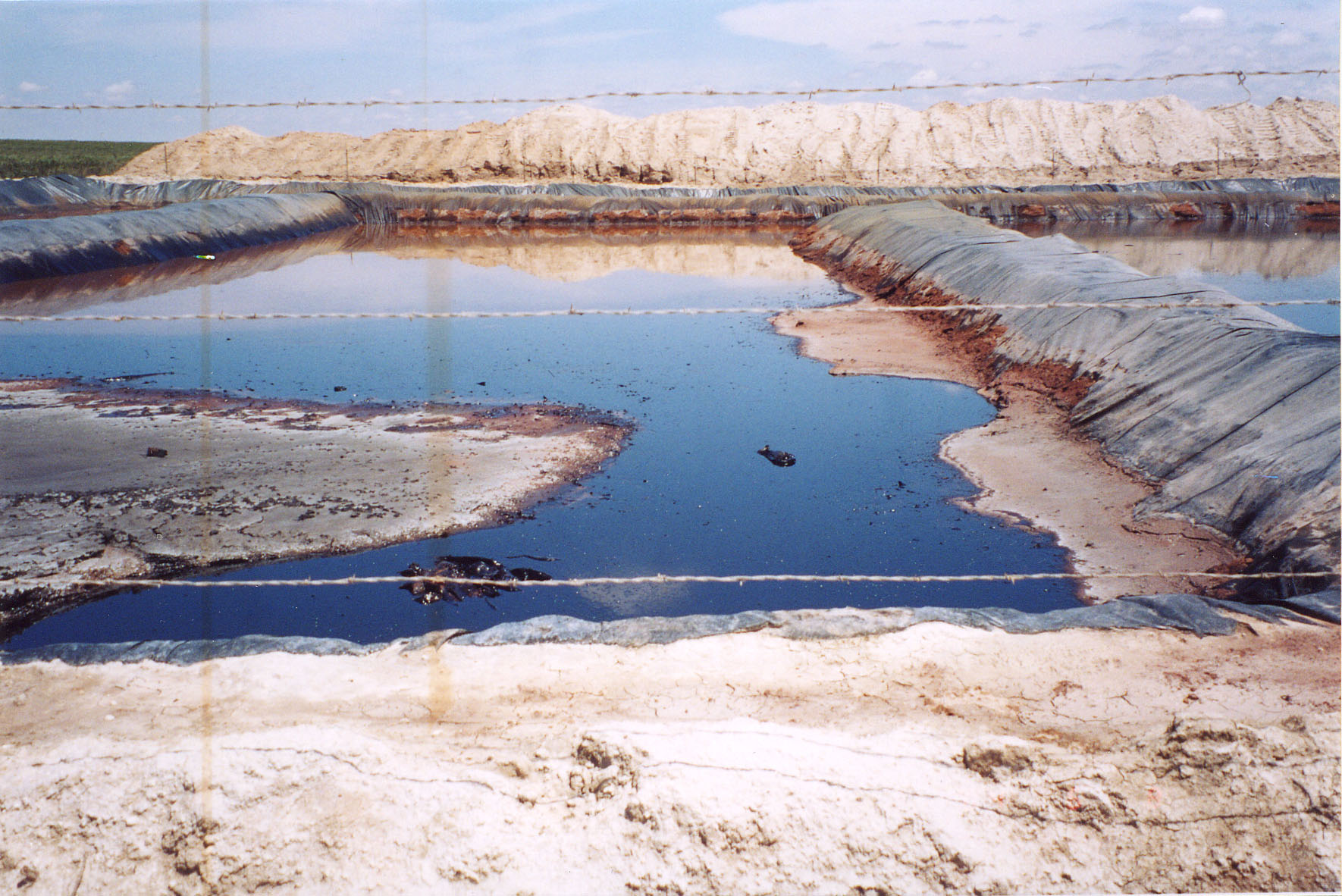 Oily pit in SE New Mexico |
In the report Wildlife Mortality Risk in Oil Field Waste Pits (download the pdf version of the report), the U.S. Fish and Wildlife Service (FWS) has documented numerous problems related to contaminants in oil field waste pits. In Wyoming, the U.S. Fish and Wildlife Service has found deer, pronghorn, waterfowl, songbirds and rabbits in oil pits. Even if animals are not killed in the pits, the oil and chemicals in the pits may affect their health. For example, if animals absorb or ingest oil, they may become more susceptible to disease and predation. The U.S. FWS web site contains information on Contaminant Issues – Oil Field Waste Pits. This web site lists numerous wildlife-related problems associated with oil and gas pits, such as:
- Skim ponds are a fatal attraction to migratory birds
- Birds, bats and other wildlife mistake pits for wetlands
- Birds landing on waste pits can get covered with oil
- Oil can weigh birds down and cause them to drown Many bird deaths go undetected because the carcasses sink to the bottom of the pits
- Oil destroys the feathers’ ability to insulate the birds resulting in death from heat or cold stress
- Even a light sheen on the water surface can be deadly. Oil on the feathers of female birds can be transferred to their eggs back at the nest, killing the embryo. Small amounts of oil applied externally to an egg shell can be extremely toxic to embryos
- Some birds become victims of pits when they feed on insects trapped in oil covering the surface of the water
- Animals scavenging on dead birds at these pits often succumb to the toxic effects of oil
Examples of wildlife and livestock deaths from pits:
Chris Velasquez, Rancher – Blanco, New Mexico. “I have complained repeatedly to BLM [Bureau of Land Management] about a shallow pit filled with “black gunk” near a gas well operated by Williams. The pit was on my grazing lease and I found cattle tracks to the pit and feared animals might be drinking the oily water. I’ve found dead cows near oil pits before, and seen lots of dead birds and other wildlife floating in the oil pits so I was worried this cow would drink out of the pit and die too. I lose eight to ten cows each year because of the oil field activity.” (San Juan Citizens Alliance and New Mexico Wilderness Alliance A High Price to Pay: Consequences of oil and gas production.)
Eliminating Oilfield Hazards. “Service special agents continued to conduct oilfield task force operations throughout historic petroleum production areas in New Mexico, Oklahoma and Texas. In New Mexico, special agents conducted ground inspections of oil pits in Sandoval, Rio Arriba, and San Juan Counties in April 2001. Netting violations detected at eight production sites were referred to the New Mexico Oil Conservation Division for State follow-up. In August, oil field inspections in the southeastern part of the State documented multiple hazards and recovered 17 oil-covered birds; seven operators paid $6,425 in fines for violating the Migratory Bird Treaty Act. Dead birds were also discovered at several sites on Bureau of Land Management property in the State; the companies holding the oil leases paid over $8,000 in fines. (U.S. Fish and Wildlife Service, Division of Law Enforcement, Annual Report 2001. Download a copy of the report.)
Regional Task Force Continues to Address Open Oil Field Pits and Tanks. “Service Special Agents throughout the region continued to investigate oil field pollution impacting migratory birds and other wildlife on historic oil fields in Oklahoma, Texas , and New Mexico. Three task force inspection operations were recently culminated following joint inspections of problematic well sites “Oil” and “G” initially documented by aerial surveillance. The Central Oklahoma operation resulted in the recovery of 32 oil covered migratory songbird and raptor carcasses from open pits or tanks operated by seven oil companies and the assessment of collateral fines totaling $11,900.” (The Federal Wildlife Officer Association Inc. The Federal Wildlife Officer, Vol. 15, Spring 2002)
Is it possible to keep wildlife out of pits?
Measures to protect wildlife and livestock from toxic substances in pits include:
- systems to prevent oil from entering waste pits;
- immediately cleaning up any oil spills that find their way in open pits;
- adequate fencing around waste pits;
- netting to keep birds from entering pits.
Unfortunately, the devices used to keep out livestock and wildlife out of pits are often inadequate. For example, if netting is not installed properly or maintained well enough (e.g., if there are tears in the netting or if it sags into the waste pit, which is common after it snows), birds are still able to access the pits.
Nets should be installed four or five feet above the pits to allow for sagging. Similarly, fencing can be used, but often, wildlife and livestock can still access pit areas.
Toxic Materials Stored and Disposed of in Pits
There are a variety of toxic substances utilized and created during the oil and gas extraction process. These include:
- Drilling fluids and wastes
- Production chemicals and wastes
- Produced water
Potentially hazardous oil and gas wastes that may be found in pits.
| Benzene(mg/l) | Arsenic (mg/l) | Barium (mg/l) | Cadium (mg/l) | Chromium (mg/l) | Lead (mg/l) | Selenium (mg/l) | |
| Should be considered hazardous if above: | 0.5 | 5 | 100 | 1 | 5 | 5 | 1 |
| Production pit sludges | 24 | 18.3 | 1.59 | ||||
| Production Sands/Solids | 2,500 | 9.9 | 5.98 | 4.11 | |||
| Workover/completion fluids | 1,530 | * | * | * | * | * | * |
| Produced water – fresh | 1.3 | 646 | |||||
| Produced water – salt | 543 | 372 | 27.8 | 7.25 | 14.4 | 2.83 | |
| Oil-based drilling muds/cuttings | 293 | 6.5 | 101 | 18.8 | 12.6 | ||
| Water-based muds/cuttings | 1,100 | * | * | * | * | * | * |
* heavy metals were not analysed
Federal regulation of oil and gas waste is inadequate
Despite the fact that many of the waste produced during exploration and production (E&P) are toxic, most of these wastes are not subject to federal hazardous waste law – Resource Conservation and Recovery Act (RCRA).
This exemption was granted despite the fact that toxic substances are contained in the wastes, and the fact that contamination of groundwater, surface water, air and soil have occurred and continue to occur from oil and gas activities. Even the U.S. Environmental Protection Agency acknowledges that although these oil and gas wastes are exempt from hazardous wastes regulations, the exemption does not mean these wastes could not present a hazard to human health and the environment if improperly managed.[2]
[1] Letter from Roger C. Anderson, Environmental Bureau Chief, New Mexico Energy, Minerals and Natural Resrouces Department, to Jennifer Goldman, OGAP. Oct. 23, 2003.
[2]Environmental Protection Agency. Oct. 2002. Exemption of Oil and Gas Exploration and Production Wastes from Federal Hazardous Waste Regulations.
For More Information
Publications
Related OGAP Web Pages
- Alternatives to Pits
- Groundwater Contamination from New Mexico Oil and Gas Facilities and Pits
- Oil and Gas Waste Disposal
- Oil and Gas Pollution

